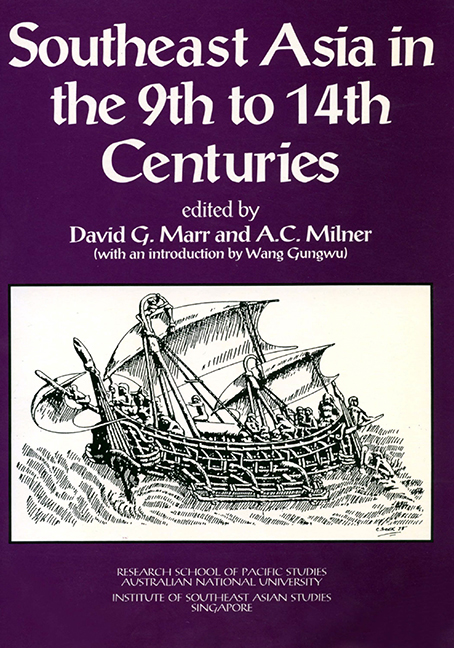Book contents
- Frontmatter
- Contents
- Contributors
- Preface
- Introduction
- 1 The Early and the Imperial Kingdom in Southeast Asian History
- 2 Hydraulic Works and South East Asian Polities
- 3 Some Notes on Relations between Central and Local Government in Ancient Java
- 4 Negara, Mandala, and Despotic State: Images of Early Java
- 5 Some Remarks on Early State Formation in Cambodia
- 6 “Elephants Can Actually Swim”: Contemporary Chinese Views of Late Ly Dai Viet
- 7 Authority and Legitimacy in 11th Century Vietnam
- 8 From Myth to History: Imagined Polities in 14th Century Vietnam
- 9 Shipshape Societies: Boat Symbolism and Political Systems in Insular Southeast Asia
- 10 Changing Perspectives in Island Southeast Asia
- 11 Political and Cultural Continuities at Dvaravati Sites
- 12 The True and the Corbel Arch in Mainland Southeast Asian Monumental Architecture
- 13 Vietnamese Ceramics and Cultural Identity: Evidence from the Ly and Tran Dynasties
- 14 Traditions, Acculturation, Renovation: The Evolutional Pattern of Vietnamese Culture
- 15 Symbolism of Kingship in Arakan
- 16 Buddhism in Champa
- 17 The Ordering of Generations: Change and Continuity in Old Javanese Kinship
- 18 Sources on Economic Activities in Khmer and Cham Lands
- 19 Narrative Bas-Reliefs at Candi Surawana
- 20 Possibilities for a Reading of the 1293-1357 Period in the Vietnamese Annals
- Index
- Miscellaneous Endmatter
18 - Sources on Economic Activities in Khmer and Cham Lands
Published online by Cambridge University Press: 21 October 2015
- Frontmatter
- Contents
- Contributors
- Preface
- Introduction
- 1 The Early and the Imperial Kingdom in Southeast Asian History
- 2 Hydraulic Works and South East Asian Polities
- 3 Some Notes on Relations between Central and Local Government in Ancient Java
- 4 Negara, Mandala, and Despotic State: Images of Early Java
- 5 Some Remarks on Early State Formation in Cambodia
- 6 “Elephants Can Actually Swim”: Contemporary Chinese Views of Late Ly Dai Viet
- 7 Authority and Legitimacy in 11th Century Vietnam
- 8 From Myth to History: Imagined Polities in 14th Century Vietnam
- 9 Shipshape Societies: Boat Symbolism and Political Systems in Insular Southeast Asia
- 10 Changing Perspectives in Island Southeast Asia
- 11 Political and Cultural Continuities at Dvaravati Sites
- 12 The True and the Corbel Arch in Mainland Southeast Asian Monumental Architecture
- 13 Vietnamese Ceramics and Cultural Identity: Evidence from the Ly and Tran Dynasties
- 14 Traditions, Acculturation, Renovation: The Evolutional Pattern of Vietnamese Culture
- 15 Symbolism of Kingship in Arakan
- 16 Buddhism in Champa
- 17 The Ordering of Generations: Change and Continuity in Old Javanese Kinship
- 18 Sources on Economic Activities in Khmer and Cham Lands
- 19 Narrative Bas-Reliefs at Candi Surawana
- 20 Possibilities for a Reading of the 1293-1357 Period in the Vietnamese Annals
- Index
- Miscellaneous Endmatter
Summary
Until recent years, scholars have not been very much attracted to specific research work on ancient economic activities in Cambodia, or at least only a few papers specially devoted to this subject have been published. Reasons for this have been given: source material had first to be published, an historical framework established, etc. Of course, these are not bad reasons, but it must be added that this research work appears to be very difficult since the sources, when viewed in entirety, seem especially difficult to interpret.
However, in the past various authors have given their opinions on the ancient economy, but it is easy to show that these opinions are often not very realistic, as they are based more on general, and if I may make so bold as to say, preconceived ideas on this civilization, rather than on facts. For example, it is a current idea that the Khmer society, which was able to make Angkor and all its wonders, was basically different from that of modern Cambodia, and it is apparent that old Khmer society is explained more appropriately through ancient Egyptian society[1] than through the comparatively well known Khmer society at the end of XlXth century. The firm belief of the present author is that such a postulation must be rejected, and without denying an evolution which is simply normal, the structure of the Khmer society at the beginning of the French protectorate naturally follows that of Angkorean society. In any case, nothing seems to hinder seriously this opinion and it provides a better hypothesis with which to commence an analysis.
Research into the economic activities of this society must include many elements which I am probably unable to appreciate properly. As an epigraphist, I shall attempt to dwell on the area with which I am most familiar, which should not imply that I consider it the most important source.
The Khmer and Cham lands will be dealt with separately. I wished to mention both of them in the title because I think the unfortunate Champa has been ignored for many years. But it is true that I know Khmer epigraphy far better and that in any case, Cham epigraphy, different from the Khmer, offers even less information about economic activities.
- Type
- Chapter
- Information
- Southeast Asia in the 9th to 14th Centuries , pp. 327 - 334Publisher: ISEAS–Yusof Ishak InstitutePrint publication year: 1986



